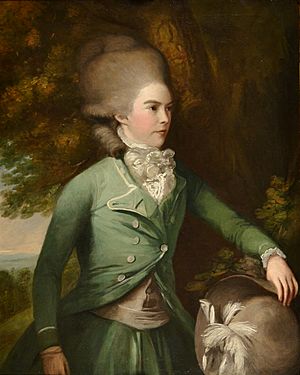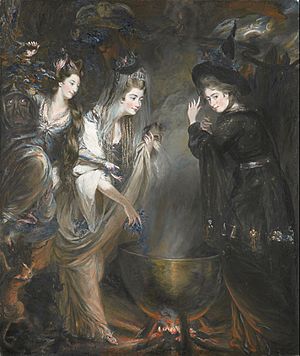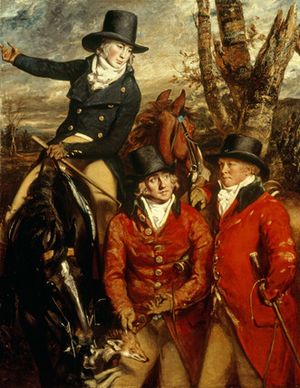Daniel Gardner facts for kids
Quick facts for kids
Daniel Gardner
|
|
|---|---|

Self-portrait in oil (around 1780). Given by Daniel Gardner's great-great-granddaughter, Miss Frances Baker, to the National Portrait Gallery, London in 1923.
|
|
| Born |
Daniel Gardner
1750 Kendal, Westmorland, England
|
| Died | 8 July 1805 London, England
|
| Nationality | English |
| Known for | Portraitist |
Daniel Gardner (1750 – 8 July 1805) was a British painter. He was best known for painting portraits of people. Gardner had a popular art studio in Bond Street in London. He often painted small portraits using pastels, crayons, or gouache (a type of watercolor). He sometimes used poses similar to those in paintings by the famous artist Joshua Reynolds.
Some art experts think Gardner was a very important artist. They admire his unique, free, and elegant style. They even see hints of impressionism in his work.
Contents
Becoming an Artist
Daniel Gardner learned from the painter George Romney. However, Gardner felt he didn't learn much from him. Around 1767, Gardner moved to London. In 1770, he became a student at the Royal Academy of Arts. There, he learned from several famous teachers.
In 1771, Gardner won a silver medal from the Royal Academy. This was for a portrait of an old man. It was likely a pastel drawing. A letter from his grandson in 1856 said the portrait was called The Chained Captive. After this, Gardner didn't show many works at big London art shows.

Around 1773, Daniel Gardner worked with Joshua Reynolds. People say that Gardner painted the trees and leaves in some of Reynolds' pictures. Reynolds' later painting style clearly influenced Gardner's work. This included how he arranged his paintings and how he painted figures.
Daniel Gardner became a very popular portrait painter. He painted many famous people of his time. These included Jane Gordon, Duchess of Gordon, Georgiana Cavendish, Duchess of Devonshire, and Charles Cornwallis, 1st Marquess Cornwallis. Because his paintings were so popular, he earned money very quickly. He could paint fast and got good prices for his work.
Gardner often stayed at the homes of his wealthy customers. This allowed him to paint many family members and even their neighbors. He saved his money carefully. In 1787, he bought his parents' old home in Kendal. He kept buying houses and land for many years. Eventually, he had enough money to stop working.
Painting Styles
Gardner was especially known for his pastel paintings. But later in the 1700s, he started mixing different techniques. He used oil paint, crayons, gouache, and pastels together. Other painters like John Downman and John James Masquerier later copied this style.
Gardner also painted large pictures using only oil paint. These are quite rare today. In a letter from 1779, Gardner said he had just finished his "very first oil picture." It was a portrait of Philip Egerton of Oulton.

It is said that Daniel Gardner made many of his own colors. He collected strange herbs and made powders from bark and fungi. However, he also bought many dry colors from a company in London.
Gardner rarely signed his artworks. Because of this, many of his paintings were later thought to be by more famous artists. People often thought they were by Joshua Reynolds or Thomas Gainsborough. This is not surprising, as Gardner worked with both of them. Art experts have noted that Gardner's style was elegant, but sometimes his drawings of faces were not as precise as Gainsborough's.
Famous writers and artists praised Gardner's work. Samuel Redgrave said Gardner "had a nice perception of beauty and character, and composed with elegance." Another writer, William Hayley, also admired Gardner's "Taste and Ease."
Sir Cuthbert C. Grundy, a president of the Royal Cambrian Academy of Art, thought Daniel Gardner was the most successful English pastel artist of the 1700s. He believed Gardner was even better than Reynolds and Downman in terms of freedom and color.
Many of Gardner's portraits were later copied as engravings or mezzotints. This was probably more profitable for Gardner than painting the original pictures.
Daniel Gardner retired when he was very famous. Because he stopped working, people almost forgot about him when he died in 1805. But in 1911, his name became famous again. His great-granddaughter sold a portrait he painted of his sister-in-law, Elizabeth Haward. It sold for a very high price at the time. This portrait is considered one of Gardner's best works.
His Life

Daniel Gardner was born in Kendal, England, in 1750. His father was a baker. His mother was related to a man named Alderman Redman. The Gardner family knew the Romney family well. George Romney's father was a cabinet maker. It is said that George Romney painted Daniel Gardner's mother when he was very young. Mrs. Gardner encouraged George Romney to become a painter. George Romney later taught Daniel Gardner.
Daniel Gardner married Ann or Nancy Haward on October 8, 1776. She was the sister of the engraver Francis Haward. Daniel and his wife had two sons. Sadly, only their older son, George (born 1778), survived. Gardner's wife died shortly after their second son was born in 1781. He was very sad after her death.
After his wife passed away, Daniel Gardner sent his son George to Kendal. George was raised by the Pennington family, who were close friends with Daniel Gardner. George later became a barrister (a type of lawyer). He married Harriet Anne Cumming and they had a son named George Harrison Gardner.
Daniel Gardner died on July 8, 1805, in London. He was buried in the churchyard of St. James's, Piccadilly. He left a large amount of money to his son George.
His Personality
Daniel Gardner was known for being a bit unusual. He sometimes asked people he was painting to come to his studio at five in the morning! He only allowed the people he was painting to be in his studio. Gardner had a special easel with shutters that could be locked. He didn't want his customers to see his work until it was finished. He always traveled with this special easel. If he stayed at a patron's house, he insisted on having a private, lockable room to work in.
Gardner didn't easily make friends with other artists. They thought he was a bit stingy. However, he became good friends with Joshua Reynolds and John Constable. Gardner even painted a portrait of Constable in 1796.
Exhibitions (after his death)
- Daniel Gardner, Amateur Art Society, London, 1910
- Daniel Gardner, 12 pastels from the collection of Lady Strachey, Cottier Gallery, New York, 1913
- Daniel Gardner, Abbot Hall Art Gallery, Kendal, 1962
- Daniel Gardner, 1750–1805, Kenwood House, London, 1972
Where to See His Art
Works by Daniel Gardner are in these collections:
- Abbot Hall Art Gallery in Kendal
- National Portrait Gallery in London
- Tate Britain
- Victoria and Albert Museum
- Montacute House
- Mitchell Library, State Library of New South Wales, Sydney
More to Read
- George Charles Williamson: Daniel Gardner, painter in pastel and gouache: A brief account of his life and works. John Lane, the bodley head, Vigo St., W, London 1921



